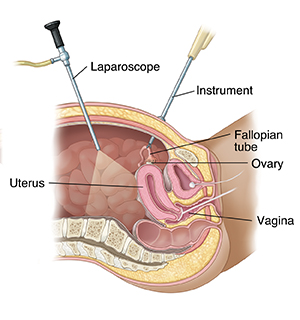What Is Reproductive Laparoscopy?
Laparoscopy is a method for surgery that can be used on the female reproductive tract. It uses a special tool called a laparoscope (scope). The scope is a thin, lighted tube with a camera on the end. The surgery is done through a few small cuts (incisions) in the belly. The scope is put through one of the incisions. It sends pictures from inside the body to a video screen.

Why laparoscopy is done
Laparoscopy helps diagnose and treat problems in the reproductive organs. It can help find the cause of symptoms, such as pain or bleeding. It can also help find reasons a person may be having trouble getting pregnant. In many cases, the problem can be treated during the same procedure. Laparoscopy may be done to find and treat:
-
Tubal pregnancy. This occurs when an embryo implants in a fallopian tube. Untreated, the tube can rupture and bleed.
-
A fibroid. This is a lump of uterine muscle tissue. This can cause pain and bleeding. These can also be diagnosed with ultrasound.
-
A blocked or damaged fallopian tube. This can cause trouble getting pregnant.
-
Endometriosis. This is when uterine tissue grows outside the uterus. This can cause pain, bleeding, cystic masses, and trouble getting pregnant.
-
Scar tissue (adhesions). These can cause pain and trouble getting pregnant.
-
A fluid-filled sac (ovarian cyst) or abnormal growth (tumor). Either can cause pain and other health problems.
-
Pelvic organ prolapse. This is when the female organs drop into or out of the vagina.
-
Incontinence. This is when urine leaks without your control.
Other reproductive organ surgeries
Laparoscopy can also be used for other reproductive organ surgeries. For instance, it may be used for tubal ligation. This surgery blocks the fallopian tubes to prevent pregnancy. Or it may be used to help remove the uterus. This is called a hysterectomy. It may be used to surgically treat ovarian cancer.
Online Medical Reviewer:
Daphne Pierce-Smith RN MSN
Online Medical Reviewer:
Rajadurai Samnishanth Researcher
Online Medical Reviewer:
Raymond Turley Jr PA-C
Date Last Reviewed:
6/1/2025
© 2000-2025 The StayWell Company, LLC. All rights reserved. This information is not intended as a substitute for professional medical care. Always follow your healthcare professional's instructions.